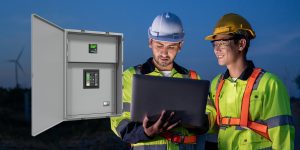Right now in the U.S., many building owners and managers are facing, perhaps for the first time, low or zero occupancy. Given the unprecedented moment, many questions need answering:
- How can I make sure my building operates efficiently during low occupancy?
- What systems should I focus on adjusting during low occupancy?
- How can I make sure my building will return properly to normal operations in the future?
This article offers answers to these questions, laying out 10 best practices on energy efficiency, safety, and reliability for low-occupancy buildings.
Important first steps
Before you begin, we recommend you reach out to your service partner, if you have one. This partner should be able to help you complete much of the work laid out in this guide, either remotely or on-site.
If you do not have a service partner, this blog post offers tips on how your own team can get started.
Checklist: 10 best practices for efficient low-occupancy buildings
- Establish your scope. First, take stock of your major HVAC and building automation assets, including chillers, air handlers, boilers, and so on. These are the key components that will be drawing energy and managing environmental conditions.
- Determine your system architecture. Find out which assets are connected to your building management system (BMS) and which assets are standalone, requiring manual control. Understanding the full scope and architecture allows you to be thorough and efficient in making these adjustments.
- Record your changes so you don’t forget them. Before you make these adjustments, be sure you record both normal settings and new settings. If you lose track of this information, you may struggle to return your building to normal operations, which could create issues with occupant comfort, HVAC performance, and safety.
- Account for regional differences. An 80 °F setpoint may turn off AC systems in Florida, as intended, but it could turn on heating systems in your New England facility. This may seem obvious, but during these confusing times, it can be easily overlooked.
- Focus on deep efficiency. Consider the difference between your typical low-occupancy setpoint (i.e., for weekends) and “deep” low-occupancy setpoints. If on weekends you typically adjust to ±5 °F off the setpoint, you might consider a deeper ±10 °F change during this time.
- Accommodate remaining staff. Remaining on-site staff (e.g., security and maintenance) will still need a comfortable climate, but will not likely be using conference rooms, gyms, or cafeterias. Lighting systems should also be adjusted accordingly. Depending on your climate, you can adjust window blinds to reduce heating or cooling demand.
- Factor in your new BTU loads. It’s not just a matter of turning the thermostat down a few degrees. You should also factor in lower BTU loads (i.e., heat generated by occupants, their computers, etc.), which will also change. Your HVAC system was likely designed for higher BTU loads.
- Modify your ventilation and economizer systems. During low occupancy, you have more flexibility in your temperature ranges, so you can turn down ventilation and rely more on outside air cooling via economizers. Doing so will reduce energy demand.
- Keep humidity in check. If you’re changing your temperature setpoints, don’t forget about humidity. Mold and moisture can become a problem if indoor dew points are not properly calibrated. ASHRAE recommends keeping relative humidity levels below 65 percent.
- Adjust fans, fridges, and freezers. Commercial kitchens and labs have exhaust and make-up fans that often run 24/7, but likely won’t be needed during this time. And if you no longer need refrigerators or freezers to store food, shut them down.
Going beyond the low-hanging fruit
This 10-part list is just the basics of what you can do to drive efficiency in your buildings during low occupancy. Every building is different and will have unique savings opportunities.
And if you’re unsure about getting this work done yourself, our field service engineers can help, whether face-to-face or remotely. Call our service hotline at 877-822-2601 or contact your local account representative to get started.




Conversation
Thanks for sharing amazing post
If in doubt, ask your service provider! That’s what we are here for! Also, you may want to consider looking at further energy savings once the building re-occupies!